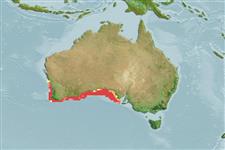Élasmobranches (requins et raies) (sharks and rays) >
Rajiformes (Skates and rays) >
Arhynchobatidae (Softnose skates)
Etymology: Irolita: From Irolita, a princess in love with prince Parcinus. The beauty of the princess was worthly the world´s admiration. Mythology.
Environment: milieu / climate zone / depth range / distribution range
Écologie
marin démersal; profondeur 50 - 200 m (Ref. 6871). Temperate; 29°S - 36°S, 113°E - 136°E (Ref. 114953)
Eastern Indian Ocean: south-western Australia.
Length at first maturity / Taille / Poids / Âge
Maturity: Lm ?, range 46 - ? cm
Max length : 52.0 cm TL mâle / non sexé; (Ref. 6871)
Occur over soft bottoms of the continental shelf (Ref. 7300, 75154). Oviparous. Distinct pairing with embrace. Young may tend to follow large objects, such as their mother (Ref. 205). Eggs are oblong capsules with stiff pointed horns at the corners deposited in sandy or muddy flats (Ref. 205). Egg capsules are 5.1-7.6 cm long and 3.2-3.8 cm wide (Ref. 41308). Males reaches maturity at ca. 46 cm TL. Occassionally caught as bycatch and typically discarded (Ref. 114953).
Life cycle and mating behavior
Maturité | Reproduction | Frai | Œufs | Fécondité | Larves
Oviparous, paired eggs are laid. Embryos feed solely on yolk (Ref. 50449). Distinct pairing with embrace. Young may tend to follow large objects, such as their mother (Ref. 205).
McEachran, J.D. and K.A. Dunn, 1998. Phylogenetic analysis of skates, a morphologically conservative clade of elasmobranchs (Chondrichthyes: Rajidae). Copeia 1998(2):271-290. (Ref. 27314)
Statut dans la liste rouge de l'IUCN (Ref. 130435)
Menace pour l'homme
Harmless
Utilisations par l'homme
Plus d'informations
PaysZones FAOÉcosystèmesOccurrencesIntroductionsStocksÉcologieRégime alimentaireÉléments du régime alimentaireConsommation alimentaireRation
Taille/Âge
Croissance
Longueur-poids
Longueur-longueur
Fréquences de longueurs
Morphométrie
Morphologie
Larves
Dynamique des populations larvaires
Recrutement
Abondance
BRUVS
RéférencesAquacultureProfil d'aquacultureSouchesGénétiqueElectrophoresesHéritabilitéPathologiesTraitementNutrientsMass conversion
CollaborateursImagesStamps, Coins Misc.SonsCiguateraVitesseType de nageSurface branchialeOtolithesCerveauxVision
Outils
Articles particuliers
Télécharger en XML
Sources Internet
Estimates based on models
Preferred temperature (Ref.
123201): 15 - 18.5, mean 16.6 °C (based on 27 cells).
Phylogenetic diversity index (Ref.
82804): PD
50 = 0.7500 [Uniqueness, from 0.5 = low to 2.0 = high].
Bayesian length-weight: a=0.00550 (0.00273 - 0.01106), b=3.10 (2.93 - 3.27), in cm total length, based on LWR estimates for this (Sub)family-body shape (Ref.
93245).
Niveau trophique (Ref.
69278): 3.8 ±0.7 se; based on size and trophs of closest relatives
Résilience (Ref.
120179): Faible, temps minimum de doublement de population : 4,5 à 14 années (Fec assumed to be <100).
Fishing Vulnerability (Ref.
59153): Moderate vulnerability (41 of 100).
